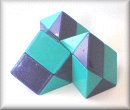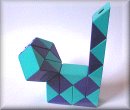Rubik's Snake
Rubik's Snake (also: Rubik's Twist, Rubik's Transformable Snake or Rubik's Snake Puzzle ) is a toy that consists of 24 three-sided straight prisms connected one behind the other . The prisms can be rotated towards each other so that different shapes and figures are created.
The starting point is usually the straight line, from which figures such as a snake, a cat, a dog, a ball and many other imaginative shapes can be formed with a few turns.
The toy does not require any special “strategies” and promotes creativity and spatial awareness .
construction
The 24 prisms are alternately connected to each other in a normal and upside-down position. The prisms can each assume four stable positions offset by 90 ° on the 23 rotating surfaces. Usually the prisms are alternately two-colored.
notation
Sequence of instructions for turning
The description of any shape or figure is based on an instruction sequence of rotations of the prisms.
The starting point is the straight line, with the 12 prisms below being numbered from 1 to 12 from left to right. The left and right rotating surfaces of these prisms are labeled L and R. The four possible positions per rotating surface are numbered 0, 1, 2 and 3 (rotation of the neighboring prisms to the lying prism). The numbering results from the view from the right on the axis of rotation in a clockwise direction. The 0 position corresponds to the starting position and is therefore not noted separately.
Each rotation is described by:
- Number of the prism: 1 to 12
- left or right prism side: L or R
- Rotation position: 1, 2 or 3
- Example for ThreePeaks
- 6R1-6L3-5R2-5L3-4R2-4L1-1R1-3L3-3R2-7L2-7R3-8L1-8R2-9L1-9R2-10L3-12R3-11L1-10R2
- Example for cat
- 9R2-9L2-8L2-7R2-6R2-6L2-5L3-4L2-3R2-2R2-2L2
Machine processing
The positions of the 23 rotating surfaces can also be written directly one after the other. The positions 0, 1, 2 and 3 always result from the rotation of the right prism relative to the left prism when viewed from the right onto the axis of rotation in a clockwise direction.
However, this notation is unsuitable for manual rotation, because it does not reveal the sequence of rotations.
- Example for ThreePeaks
- 10012321211233232123003
- Example for cat
- 02202201022022022000000
mathematics
The number of theoretically different forms of Rubik's Snake is
4 23 = 70 368 744 177 664 ≈ 7 · 10 13
It results from the number of 4 positions of the 23 rotating surfaces.
However, the actual number of different forms possible is fewer and still unknown. This is because some combinations of rotations cannot be performed because parts of the resulting figure would overlap.



